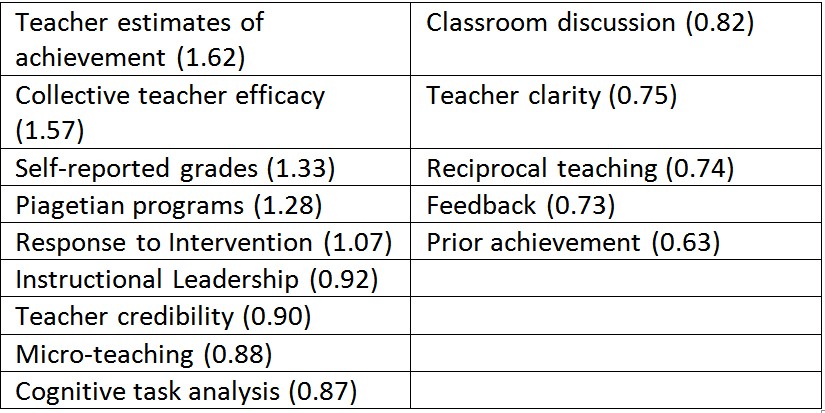Improving Performance – Transforming the Narrative
- On 23-02-2017
Is your school’s narrative leading to the practices, structures and the results you want?
The Research on What Works
By now we have no doubt that you and your school’s practices would have influenced by John Hattie’s synthesis and analysis of what works (and what doesn’t) in educational research. His intent was solely to provide some basis for teachers, schools and educational systems to compare the actual research evidence on learning.
 Figure 1: Top Variables as of September 2016
Figure 1: Top Variables as of September 2016
Whether one agrees with the “rankings”, the value of the “effect size” or not, they do give an indication of the relative effect that an approach is likely to have on student learning. You’ll notice that most of these variables in the table above are teacher-driven – which reflects the significant impact we know that teachers have on student learning experiences and outcomes.
Yet where are teachers currently driving learning? What could be influencing the embedding of great evidence based practice?
The Current Narrative
As part of workshops we ran throughout 2016 we spent quite a bit of time with teachers and school leaders unpacking the current perceived status or narratives within their schools. It is a nice exercise which can be quite revealing as it draws out the pre-dominant conversations within the school.
There were two clear narrative trends we noticed across most schools:
- A perceived lack of strategic thinking and planning across the school
- A perceived lack of clear communication and leadership across the school
Think about what this may be like for a moment. You are a teacher who is – day in and day out – interacting with a wide variety of students of varying capacity with the goal of supporting them to grow and progress in their learning and understanding. You try to improve your teaching each day and you occasionally go to external professional learning sessions and are lucky to embed one good idea you learnt from them. You don’t get the time you feel you need to interact professionally with your colleagues and often the meetings you do have devolve into administrivia and sometimes people disagreeing with one another. Curriculum days, if you have them, are either at the end of the year, start of the year or spent doing things that are not linked to curriculum but covering required well-being or other aspects (e.g. anaphylaxis, first aid, etc). The school leadership is working on embedding evidence based practice within the school but it is mostly a top down approach and the goal posts seem to be always moving depending on the latest “research”. The last time you really developed your capacity to be an effective teacher in a rigorous manner was when you were working on your teaching degree or when you did your Masters.
It is not surprising that the impact of these pre-dominant narratives often resulted in teachers and middle leaders feeling disenchanted, overworked and at the effect of constant change and initiatives. Furthermore, the systems within the school – those structures / practices / policies that create the work-ability within the school – are designed to keep the current paradigm in place. The result is glacial improvement or consistent mediocrity since the system is working against improvement.
Transforming the Narrative
Improvement or transformation comes with shifting the narrative within the school and aligning the school vision, systems, practices, processes and policies to achieve the common goals.
- It requires harnessing the school community to “all be rowing in the same direction” and making the goals and progress towards them explicit and visible (rather than owned by a few)
- It requires long term strategic thinking and planning and distributed leadership.
- It requires a shift in who people believe is responsible for learning and leadership within the school.
- It requires clear and constant communication and sharing
This is not easy and takes significant time but it has become more important as schools exist in a constantly changing societal and technological landscape. Hattie, in a recent presentation Shifting away from distractions to improve Australia’s schools: Time for a Reboot, suggest schools reboot themselves. We agree. If you re-look at the highest effect size data in the table above you will notice that they are pointing directly to the importance of teachers developing a shared common understanding and working together for a common goal.
This year many of our newsletters, articles, and workshops will be focused on what we see are the practicalities of rebooting your school and creating a narrative within the school that empowers learning and leadership. Our aim is to provide new contexts, new thinking and practical examples so you begin the journey of creating the school culture you have always wanted.
Some Questions for you to think about
- What are the current narratives or perceptions of teachers, middle leaders and students within the school?
- What do they say are the causes of these perceptions / narratives within the school?
- What is the future you would like to see for learning / school culture?


0 Comments